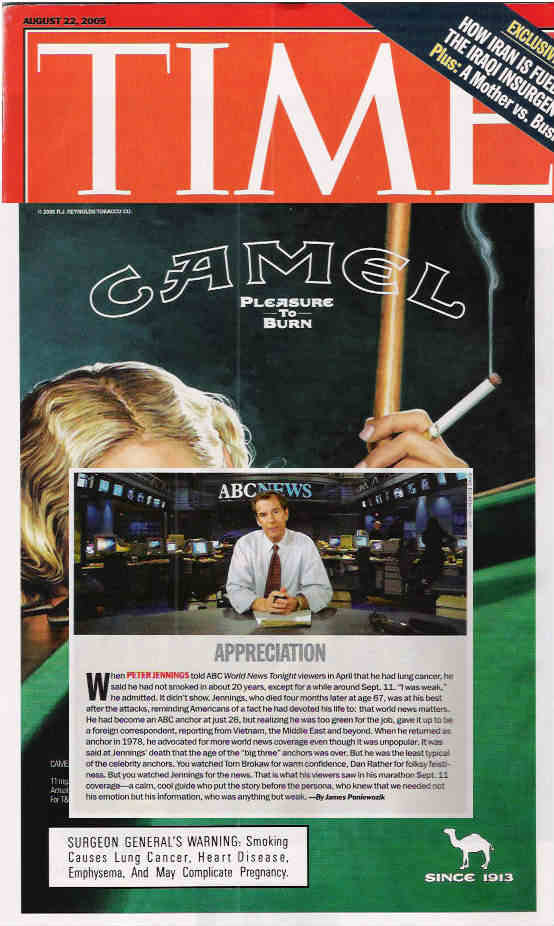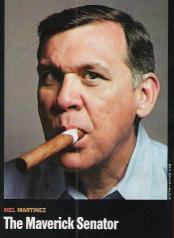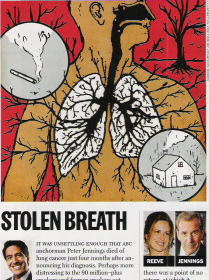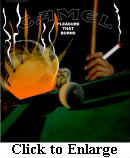TIME pays greater tribute to smoking than Jennings

The above image is a composite of portions of three pages of the August 22, 2005 issue of TIME magazine. It shows the top 2.5 inches of TIME's cover above a full-page R.J. Reynold's Camel advertisement appearing on page 2, with TIME's page 21 tribute to Peter Jennings superimposed upon the page 2 Camel ad.
Page 2 of the August 22, 2005 issue of TIME magazine features a full-page R.J. Reynolds advertisement for Camel cigarettes. Buried on page 21 of the issue is a short one-third page tribute to ABC News anchor Peter Jennings, who died of smoking related lung cancer on August 7, 2005.
In the Camel ad, a good-looking blue-eyed blonde holds a cigarette and cue in one hand while eyeing her next shot on a green felted pool table. The message above her reads, "Pleasure to Burn." Prophetically, the Surgeon General warning at the bottom reads in part "Smoking Causes Lung Cancer." To the right is a Camel. Below it the words, "Since 1913."
"The Camel is grinning," says Dr. Pankaj Chaturvedi, "it has now got Jennings." Dr. Chaturvedi has every right to be outraged. He's a front line cancer surgeon whose daily wades through tobacco's carnage. "They sell poison for money," he reminds us. Dr. Chaturvedi created a spoof of R.J. Reynolds' "Pleasure to Burn" ad, having retitled it "Pleasure that Burns."
 With a rather large page 47 picture of Senator Martinez chomping on a big cigar, the issue clearly devotes far more space to Peter's killer -- tobacco -- than to Peter Jennings' amazing life and needless absence. What does it say about the priorities and sensitivities of TIME's editors and publisher?
With a rather large page 47 picture of Senator Martinez chomping on a big cigar, the issue clearly devotes far more space to Peter's killer -- tobacco -- than to Peter Jennings' amazing life and needless absence. What does it say about the priorities and sensitivities of TIME's editors and publisher?
Time Warner, the world's largest media corporation, is parent owner of more than 130 magazines, including TIME. It has a long and extremely destructive heritage of partnering with the tobacco industry in helping entice young readers to sample what many dependency experts consider earth's most captivating chemical. Both must live with the sobering reality that almost 90% of all new smokers continue to be children or teens, as happened to Peter Jennings at age 13.
The last thing Peter Jennings would have wanted was to become a poster child for any cause. His beat was the news. His thing, getting the story right. But getting it right is something TIME simply cannot do when it comes to identifying and exposing the villains playing key roles in keeping addiction to smoking nicotine America's leading cause of death.
 Not only does the opening line of TIME's tribute suggest the possibility that Peter had quit smoking for too long to declare his lung cancer smoking related, on page 71 readers are greeted with a lung graphic, above tiny pictures of Jennings and Reeves that, on its face, gives equal weight to the proposition that naturally occurring home radon exposure and smoking are equal villains in causing lung cancer.
Not only does the opening line of TIME's tribute suggest the possibility that Peter had quit smoking for too long to declare his lung cancer smoking related, on page 71 readers are greeted with a lung graphic, above tiny pictures of Jennings and Reeves that, on its face, gives equal weight to the proposition that naturally occurring home radon exposure and smoking are equal villains in causing lung cancer.
TIME again reminds them that Peter quit for 20 years. It mentions his relapse during 9/11 but fails to share how long or how much he smoked before quitting again. It tells readers that the second leading cause of lung cancer death is radioactive radon in homes, and ends by giving seemingly equal weight to home radon checks and personal health check-ups.
Although minor, it seems a bit odd that the article attributes 85% of lung cancer deaths to smoking while both the American Cancer Society and American Lung Association assert that the rate is 87%.
The accompanying story provides statistical detail but cannot help but leave millions of ex-smokers who quit beyond age 40 feeling extremely exposed, with some probably pondering why they even quit. It cannot help but fuel the junkie-thinking of more than 40 million nicotine dependent Americans whose denial now has the added rationalization that "why quit, I'll remain at risk for lung cancer from radon or from having smoked too long anyway!"
What the article fails to mention is that the National Safety Council is selling home radon test kits for $9.95 and that most radon problems can be fixed for less than $500. Yes, homes built over uranium deposits can build-up dangerous internal concentrations of radon gas but Time Warner isn't pushing radon test kits. It's pushing use of extremely addictive nicotine while fully aware of the targets struck by reckless shotgun type marketing.
We can each quickly and painlessly detect and correct radon risks. But how easy is it to remove the millions of extra de-sensitizing nicotinic receptors that nicotine caused to quickly grow in eleven different brain regions? Unlike our ability to shield against radon, nicotine dependency is as permanent as alcoholism and is scheduled to cost half of all U.S. smokers an average of 13 to 14 years of life.
The tobacco industry knows that without effective avenues of communication permitting it to connect and burn thousands of invitations to smoke upon the brains of America's youth, impressions it hopes will collectively eventually lead to that one fateful "what the heck" moment, it cannot replace the 440,000 smokers annually claimed by smoking.
A leadership pipeline flows from the tobacco industry into major media outlets. Michael E. Miles was appointed chief executive officer (CEO) of Philip Morris USA, our nation's largest tobacco company with a 50% share, in 1991. He resigned in 1994 and was voted to Time Warner's board of directors in 1995, where today he continues to serve.
Richard D. Parsons served on the board of directors of Philip Morris USA from 1990 to 2000, before becoming Time Warner's CEO in 2002 and its Chairman of the Board in 2003. According to a December 9, 2001 news article, Mr. Parsons almost became Philip Morris's CEO in May 2001.
The tobacco industry knows that Time Warner isn't just the owner of 130+ magazines. It also owns New Line Cinema, Warner Brothers, Cinemax and HBO. According to SmokeFreeMovies, between 1999 and 2004 Time Warner youth-rated movies delivered almost 50% more tobacco impressions than its R-rated films. SmokeFreeMovies calculates that Time Warner movies, alone, are responsible for annually delivering 98,000 youth smokers to the tobacco industry.
On June 20, 2005, the National Association of Attorneys General (NAAG) boasted "major success" in negotiating an agreement to have three Time Warner magazines (TIME, People and Sports Illustrated) use selective binding, a fifteen year-old technology which allows for creation of thousands of advertising versions of each magazine, to remove all tobacco ads from issues knowingly being sent into America's middle and high schools.
For some still secret reason the NAAG failed to require Time Warner to remove tobacco ads from a host of other school-bound magazines, including Popular Science, Outdoor Life, Entertainment Weekly, and Field & Stream. On the face of things it certainly appears as though the NAAG has impliedly consented to continued in-school tobacco marketing during the 2005-2006 school year.
If the NAAG's agreement with Time Warner has you scratching your head, visit the American Legacy Foundation's (ALF) website. The ALF is the national trust created from the 1998 tobacco settlement agreement and given more than a billion dollars to oversee national youth smoking prevention efforts. Look who it lists as its #1 corporate partner. That's right, Time Warner. Confused yet?
Not only is Time Warner heavily engaged in marketing tobacco to America's youth, by doing so it creates obvious internal conflicts in allowing its major news organizations at TIME and CNN to engage in serious investigative journalism as to how the tobacco industry is able to annually hook nearly a million new youth smokers.
TIME magazine has devoted two magazine covers to breast cancer, yet no magazine cover to lung cancer, when lung cancer annually claims 4.3 times as many Americans. Why? It has devoted four covers to cocaine and none to nicotine, when nicotine is roughly six times more addictive, and addiction to smoking it annually kills 25 times more Americans than all illegal drugs combined. Why?
Will Time Warner eventually pull all tobacco ads from all magazines headed into America's schools and from magazines flowing into public and college libraries? Will it remove them from the millions of magazines being weekly pumped into hospital and doctor office waiting rooms, where the ads obviously undermine the credibility of medical cessation advice?
Will Time Warner voluntarily bring an end to the practice of having youth Hollywood idols smoke in youth rated movies, or will it wait and eventually compel government intervention? What hope is there if the smoking induced lung cancer death of America's most beloved and respected news anchor could not briefly pause Time Warner's relentless campaign to chemically enslave America's youth?



